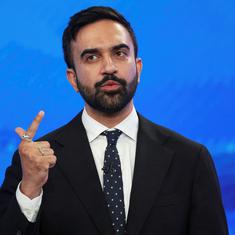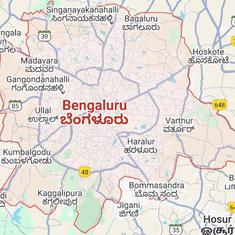It was dark, and the elevated expressway connecting Bengaluru to its information technology heartland was slick from the rain, but the teenage drivers of three cars did not think it was a bad idea to race one another. They had apparently, the police said, done this often.
At 3 am, the three friends were barrelling along at about 150 kmph, one following the other, when the 17-year-old driver of the first car scraped the parapet of the expressway. The car bounced off the parapet and careened into a set of 10 barricades at the end of the road. Either his head popped out of the car window or a barricade smashed into the car. Either way, the teen was decapitated. The second car jumped the median and smashed into an oncoming milk truck. The car driver was lucky to escape with minor injuries; the milk truck driver survived and fled. The third car hit the median, but screeched to a halt.
The teen’s gruesome end earlier this week shocked a city and state otherwise inured to road accidents and death, worse even than India’s abysmal standards, where a person dies in a road accident every three minutes or 17 every hour, as IndiaSpend reported this week. More than 1.5 million have died over the decade to 2016 and 5.5 million have been seriously injured – India now has more crashes than any other country – tangling the criminal justice system in thousands of cases and causing a loss equivalent to 3% of gross domestic product.
The 9.2-km, four-lane elevated expressway – often dark because of unpaid electric bills – where the teen died claimed 32 lives in the first seven months of 2017. Bengaluru is India’s fifth most populous city, but it ranks third by road accidents, which occur every 99 minutes, killing more people than much larger Mumbai. Karnataka is India’s ninth most populous state, but it ranks third by road accidents, according to the latest government data.
The teen’s decapitation was the result of his actions – the police arrested the parents of the three friends, holding them responsible – as it is nationwide, with 84% of accidents caused by driver error, of which 66% were due to speeding. It is no surprise then that about 80% of Indian road users feel unsafe, according to a 2017 10-city survey by the SaveLife Foundation, an award-winning advocacy. Much of that is related to their own behaviour: 78% of respondents confessed to not wearing a seat belt in a car, and 46% of two-wheeler riders did not wear a helmet.
A weapon, not a vehicle
The reason India is faced with this tide of accidents and death, said SaveLife founder Piyush Tewari, is because the Indian government certification is limited to testing a driver’s ability – if that – to operate transport machinery, not to drive safely. “A vehicle in the hand of an untrained person is a weapon,” said Tewari, whose foundation has pioneered legislation to make roads safer and is lobbying for passage of new laws by Parliament. Tewari’s own story illustrates how road accidents are someone else’s tragedies until they strike home. His tragic epiphany came a decade ago when a 16-year-old cousin bled to death on a Kanpur road, conscious enough to pull himself to the side of the road and plead for help. None was forthcoming, even though he lay there for 45 minutes. Tewari gave up a comfortable life in private equity, started SaveLife from his savings and has since focussed on policy interventions that could make India’s deadly roads safer.
Calling road accidents a “pandemic”, Tewari’s chief prescription (others include better road engineering and enforcement) is relatively simple: shut down India’s road transport offices, better known by their acronym, RTOs.
There are nearly 1,000 of these hotbeds of corruption and inefficiency nationwide, providing a third-world certification system to a country with first-world dreams – clearing unprepared drivers and then extracting payoffs from them. The trucking industry alone paid nearly Rs 22,200 crores in bribes every year, according to a 2007 report from Transparency International India, a non-profit. More than 43% of these bribes were paid to RTO officers, with the police scooping up 45%.
Road transport offices, argued Tewari, should become what regional passport offices have become, hubs of relative efficiency after their major functions were outsourced to Tata Consultancy Services, India’s largest IT company. Once rife with corruption and touts, the passport system has used technology, eradicated retail corruption and severely limited official discretion and is now a model of what is possible in the government system.

Overhauling the RTOs
Unlike passport offices that are run by the Central government, RTOs are controlled by the states, so it should be easier to begin reforms. If one state overhauls its RTOs, the rest are likely to follow. Given its relative prosperity, rate of accidents and rich IT and startup ecosystem, that pioneering state should be Karnataka, which is one of three Opposition-controlled states (Tamil Nadu and West Bengal are the others) currently stalling the Motor Vehicles (Amendment) Bill, 2017 in the Rajya Sabha, after it was passed by the Lok Sabha in April. Think of the possibilities: you could apply for a driving licence using an app; you could submit all documents online and – like a passport application – get a test appointment online; you could be tested in a simulator for a range of driving and safety skills instead of driving in an “8” or proving you can reverse in an RTO compound.
Karnataka could show India the way forward, but the state, administered by the Congress, is also notorious for official corruption. It would take a strong leader to bulldoze vested interests and entrenched corruption to do this. But as the prime minister’s hold over India wavers, the party might want to be such a pioneer. Alternately, a prime minister desperate for a clear achievement that changes – and saves – lives might want to push a Bharatiya Janata Party state to take the first step. Either way, the country will have to soon decide what to do with its 997 RTOs.
India has made an international commitment – called the Brasilia Declaration – to reduce road accidents by 2020. That is less than three years away. “We have a big challenge ahead of us,” writes Yudhvir Singh Malik, the top bureaucrat of the road transport ministry. Quite.









